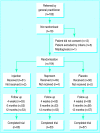Pragmatic randomised controlled trial of local corticosteroid injection and naproxen for treatment of lateral epicondylitis of elbow in primary care - PubMed (original) (raw)
Clinical Trial
Pragmatic randomised controlled trial of local corticosteroid injection and naproxen for treatment of lateral epicondylitis of elbow in primary care
E M Hay et al. BMJ. 1999.
Abstract
Objective: To compare the clinical effectiveness of local corticosteroid injection, standard non-steroidal anti-inflammatory drugs, and simple analgesics for the early treatment of lateral epicondylitis in primary care.
Design: Multicentre pragmatic randomised controlled trial.
Setting: 23 general practices in North Staffordshire and South Cheshire.
Participants: 164 patients aged 18-70 years presenting with a new episode of lateral epicondylitis.
Interventions: Local injection of 20 mg methylprednisolone plus lignocaine, naproxen 500 mg twice daily for two weeks, or placebo tablets. All participants received a standard advice sheet and co-codamol as required.
Main outcome measures: Participants' global assessment of improvement (five point scale) at four weeks. Pain, function, and "main complaint" measured on 10 point Likert scales at 4 weeks, 6 months, and 12 months.
Results: Over 2 years, 53 subjects were randomised to injection, 53 to naproxen, and 58 to placebo. Prognostic variables were similar between groups at baseline. At 4 weeks, 48 patients (92%) in the injection group were completely better or improved compared with 30 (57%) in the naproxen group (P<0.001) and 28 (50%) in the placebo group (P<0.001). At 12 months, 43 patients (84%) in the injection group had pain scores </=3 compared with 45 (85%) in the naproxen group and 44 (82%) in the placebo group (P>0.05).
Conclusions: Early local corticosteroid injection is effective for lateral epicondylitis. Outcome at one year was good in all groups, and effective early treatment does not seem to influence this.
Figures
Figure
Patient recruitment, randomisation to treatment group, and follow up rates
Similar articles
- Local steroid injections for tennis elbow: does the pain get worse before it gets better?: Results from a randomized controlled trial.
Lewis M, Hay EM, Paterson SM, Croft P. Lewis M, et al. Clin J Pain. 2005 Jul-Aug;21(4):330-4. doi: 10.1097/01.ajp.0000125268.40304.b3. Clin J Pain. 2005. PMID: 15951651 Clinical Trial. - Physiotherapy alone or in combination with corticosteroid injection for acute lateral epicondylitis in general practice: a protocol for a randomised, placebo-controlled study.
Olaussen M, Holmedal Ø, Lindbaek M, Brage S. Olaussen M, et al. BMC Musculoskelet Disord. 2009 Dec 4;10:152. doi: 10.1186/1471-2474-10-152. BMC Musculoskelet Disord. 2009. PMID: 19961603 Free PMC article. Clinical Trial. - Comparison of effects of phonophoresis and iontophoresis of naproxen in the treatment of lateral epicondylitis.
Başkurt F, Ozcan A, Algun C. Başkurt F, et al. Clin Rehabil. 2003 Feb;17(1):96-100. doi: 10.1191/0269215503cr588oa. Clin Rehabil. 2003. PMID: 12617384 Clinical Trial. - Corticosteroid injections for lateral epicondylitis: a systematic review.
Smidt N, Assendelft WJ, van der Windt DA, Hay EM, Buchbinder R, Bouter LM. Smidt N, et al. Pain. 2002 Mar;96(1-2):23-40. doi: 10.1016/s0304-3959(01)00388-8. Pain. 2002. PMID: 11932058 Review. - Comparative effectiveness of botulinum toxin versus non-surgical treatments for treating lateral epicondylitis: a systematic review and meta-analysis.
Lin YC, Wu WT, Hsu YC, Han DS, Chang KV. Lin YC, et al. Clin Rehabil. 2018 Feb;32(2):131-145. doi: 10.1177/0269215517702517. Epub 2017 Mar 28. Clin Rehabil. 2018. PMID: 28349703 Review.
Cited by
- Clinical implications of reconsideration of enthesitis/enthesopathy/enthesial erosion, as tendon attachment-localized avulsions and stress fracture equivalents.
Rothschild BM. Rothschild BM. World J Orthop. 2024 Oct 18;15(10):902-907. doi: 10.5312/wjo.v15.i10.902. eCollection 2024 Oct 18. World J Orthop. 2024. PMID: 39473521 Free PMC article. - Conservative Management of Lateral Epicondylalgia: A Review.
Uttamchandani SR, Phansopkar P. Uttamchandani SR, et al. Cureus. 2024 May 8;16(5):e59875. doi: 10.7759/cureus.59875. eCollection 2024 May. Cureus. 2024. PMID: 38854316 Free PMC article. Review. - The current status of various preclinical therapeutic approaches for tendon repair.
Liang W, Zhou C, Deng Y, Fu L, Zhao J, Long H, Ming W, Shang J, Zeng B. Liang W, et al. Ann Med. 2024 Dec;56(1):2337871. doi: 10.1080/07853890.2024.2337871. Epub 2024 May 13. Ann Med. 2024. PMID: 38738394 Free PMC article. Review. - Comparison of the Clinical Results of Platelet-Rich Plasma, Steroid and Autologous Blood Injections in the Treatment of Chronic Lateral Epicondylitis.
Kıvrak A, Ulusoy I. Kıvrak A, et al. Healthcare (Basel). 2023 Mar 6;11(5):767. doi: 10.3390/healthcare11050767. Healthcare (Basel). 2023. PMID: 36900772 Free PMC article. - The 100 most cited articles in lateral epicondylitis research: A bibliometric analysis.
Zhu S, He Z, Bi Q, Cao L, Gu H, Zhang Q, Chai F. Zhu S, et al. Front Surg. 2023 Feb 13;9:913818. doi: 10.3389/fsurg.2022.913818. eCollection 2022. Front Surg. 2023. PMID: 36860728 Free PMC article.
References
- Chard MD, Hazleman BL. Tennis elbow—a reappraisal. Br J Rheumatol. 1989;28:186–190. - PubMed
- Labelle H, Guibert R. Efficacy of diclofenac in lateral epicondylitis of the elbow also treated with immobilization. University of Montreal Orthopaedic Research Group. Arch Fam Med. 1997;6:257–262. - PubMed
- Labelle H, Guibert R, Joncas J, Newman N, Fallaha M, Rivard CH. Lack of scientific evidence for the treatment of lateral epicondylitis of the elbow. An attempted meta-analysis. J Bone Joint Surg [Br] 1992;74B:646–651. - PubMed
Publication types
MeSH terms
Substances
LinkOut - more resources
Full Text Sources
Medical
